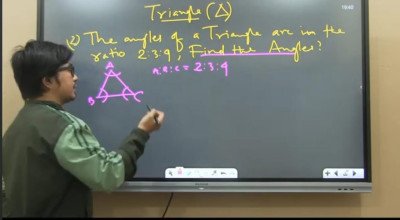Course description
We interact with different objects of different shapes; it is essential to know their surface area and volume definitions. The surface area and volume give us an idea about the shape and size of the object. The surface area mainly gives us information about the total area in the space covered by the object. The volume provides us with an idea about the capacity of an object to hold. The units used to measure the surface area and volume are m2 and m3, respectively. This article contains surface area and volume definition notes.
Surface Area
When it is placed in a space, the total space covered by an object is called the object’s surface area. A three-dimensional (having a definite length, breadth and height or depth) object, when placed in space, covers a particular area, the total area covered by the object is known as the object’s surface area.
The surface area of objects is further classified into three categories:
Lateral surface area
Curved surface area
Total surface area
Lateral Surface Area
Lateral surface area is described as the total surface area of an object, excluding the surface areas of the top and bottom parts of the object.
In other words, the lateral surface area gives the surface area of the object’s cross-section.
Curved Surface Area
Many solid objects like a cylinder and cones have a curved surface; the area of the object covered by the curved surface of such items is called the curved surface area.
Total Surface Area
The total surface area includes all the faces of the object; this gives us the total surface covered by the object in the physical space.
Surface Area Units
The surface area is always measured in square units. The unit used to measure the surface area of an object is m2; it is also called the S.I unit of surface area. However, in calculations, cm2, mm2 are also used.
Volume
The volume of an object is described as the total space occupied by the object and its capacity to hold a material or substance in it. In other words, the volume of an object gives us the total capacity of the object to hold in space.
আমরা বিভিন্ন আকারের বিভিন্ন বস্তুর সাথে যোগাযোগ করি; তাদের পৃষ্ঠের ক্ষেত্রফল এবং আয়তনের সংজ্ঞা জানা অপরিহার্য। পৃষ্ঠের ক্ষেত্রফল এবং আয়তন আমাদের বস্তুর আকৃতি এবং আকার সম্পর্কে ধারণা দেয়। পৃষ্ঠের ক্ষেত্রফল মূলত বস্তু দ্বারা আচ্ছাদিত স্থানের মোট এলাকা সম্পর্কে তথ্য দেয়। আয়তন আমাদের একটি বস্তুর ধারণ ক্ষমতা সম্পর্কে ধারণা প্রদান করে। পৃষ্ঠের ক্ষেত্রফল এবং আয়তন পরিমাপের জন্য ব্যবহৃত এককগুলি যথাক্রমে m2 এবং m3। এই নিবন্ধে পৃষ্ঠ এলাকা এবং ভলিউম সংজ্ঞা নোট রয়েছে.
ভূপৃষ্ঠের
যখন এটি একটি স্থানে স্থাপন করা হয়, তখন একটি বস্তু দ্বারা আচ্ছাদিত মোট স্থানকে বস্তুর পৃষ্ঠের ক্ষেত্রফল বলে। একটি ত্রিমাত্রিক (একটি নির্দিষ্ট দৈর্ঘ্য, প্রস্থ এবং উচ্চতা বা গভীরতা বিশিষ্ট) বস্তু, যখন মহাকাশে স্থাপন করা হয়, একটি নির্দিষ্ট এলাকা জুড়ে, বস্তু দ্বারা আচ্ছাদিত মোট ক্ষেত্রটি বস্তুর পৃষ্ঠের ক্ষেত্রফল হিসাবে পরিচিত।
বস্তুর পৃষ্ঠের ক্ষেত্রফলকে আরও তিনটি শ্রেণীতে ভাগ করা হয়েছে:
পার্শ্বীয় পৃষ্ঠ এলাকা
বাঁকা পৃষ্ঠ এলাকা
মোট পৃষ্ঠ এলাকা
পার্শ্বীয় পৃষ্ঠ এলাকা
পার্শ্বীয় পৃষ্ঠের ক্ষেত্রফলকে বস্তুর উপরের এবং নীচের অংশগুলির পৃষ্ঠের ক্ষেত্রগুলি বাদ দিয়ে বস্তুর মোট পৃষ্ঠের ক্ষেত্রফল হিসাবে বর্ণনা করা হয়।
অন্য কথায়, পার্শ্বীয় পৃষ্ঠের ক্ষেত্রফল বস্তুর ক্রস-সেকশনের পৃষ্ঠের ক্ষেত্রফল দেয়।
বাঁকা পৃষ্ঠ এলাকা
একটি সিলিন্ডার এবং শঙ্কুর মত অনেক কঠিন বস্তুর একটি বাঁকা পৃষ্ঠ থাকে; এই ধরনের বস্তুর বক্র পৃষ্ঠ দ্বারা আবৃত বস্তুর ক্ষেত্রফলকে বক্র পৃষ্ঠের ক্ষেত্রফল বলে।
মোট সারফেস এরিয়া
মোট পৃষ্ঠ এলাকা বস্তুর সমস্ত মুখ অন্তর্ভুক্ত; এটি আমাদের ভৌত স্থানের বস্তু দ্বারা আচ্ছাদিত মোট পৃষ্ঠ দেয়।
সারফেস এরিয়া ইউনিট
পৃষ্ঠের ক্ষেত্রফল সর্বদা বর্গ এককে পরিমাপ করা হয়। একটি বস্তুর পৃষ্ঠের ক্ষেত্রফল পরিমাপের জন্য ব্যবহৃত একক হল m2; একে ভূপৃষ্ঠের S.I এককও বলা হয়। যাইহোক, গণনায়, cm2, mm2 ব্যবহার করা হয়।
আয়তন
একটি বস্তুর আয়তনকে বস্তুর দ্বারা দখলকৃত মোট স্থান এবং এতে একটি উপাদান বা পদার্থ ধারণ করার ক্ষমতা হিসাবে বর্ণনা করা হয়। অন্য কথায়, একটি বস্তুর আয়তন আমাদেরকে মহাশূন্যে ধারণ করার বস্তুর মোট ক্ষমতা দেয়।




















